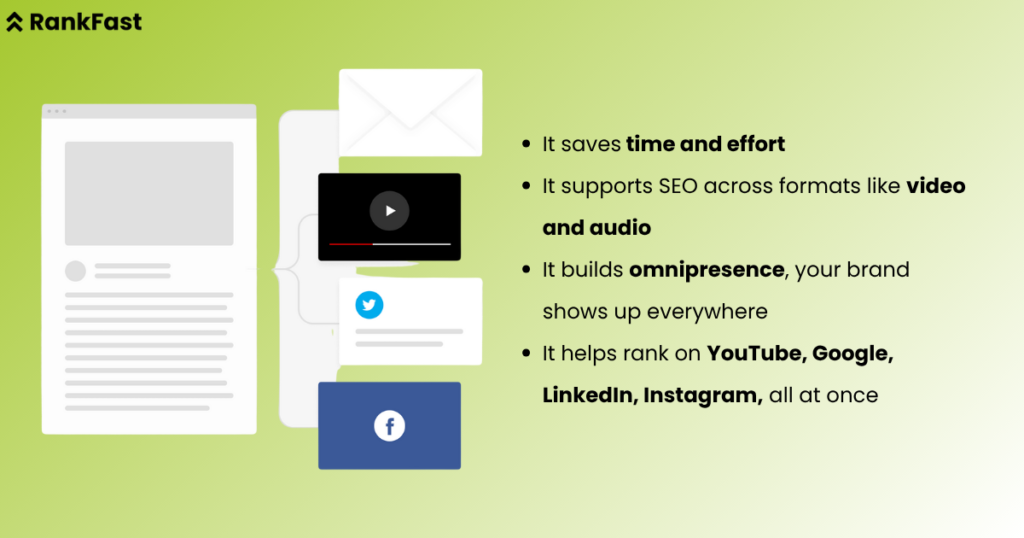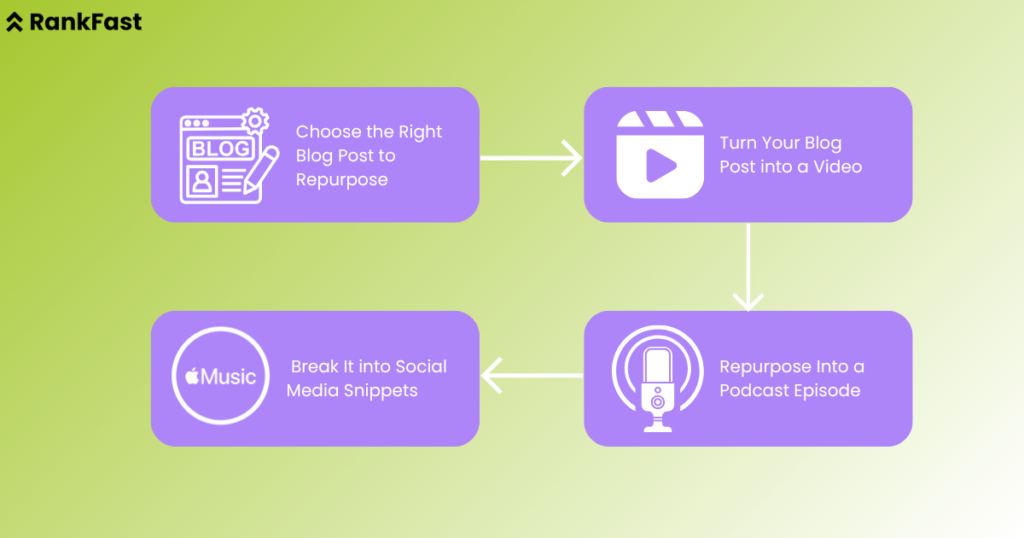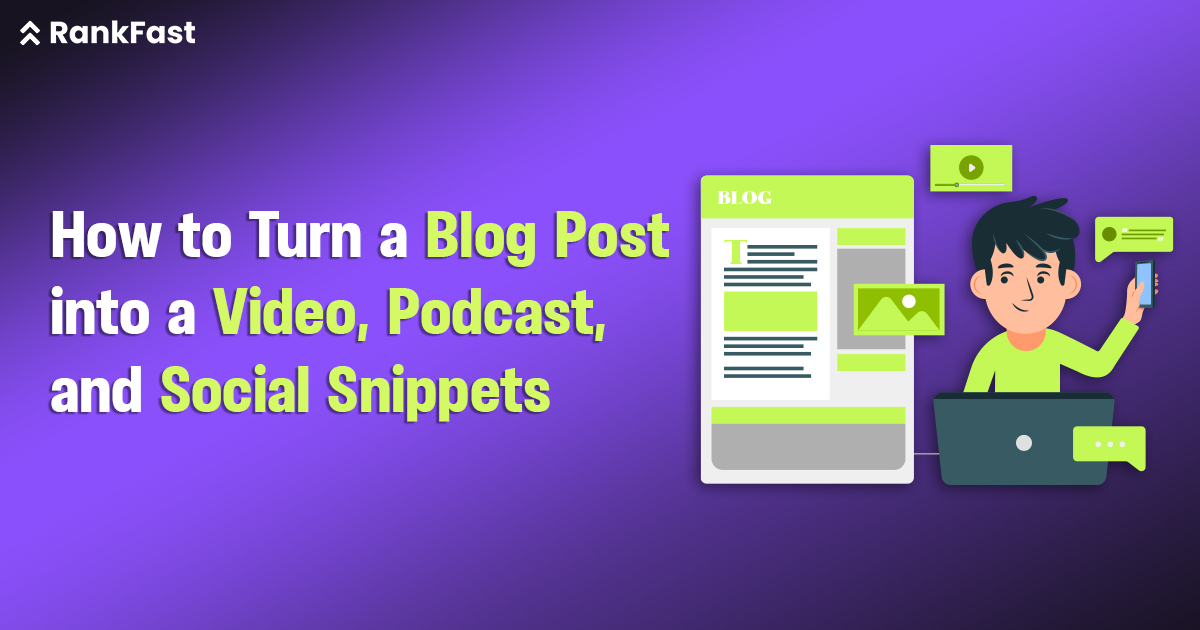Ever spent hours writing a blog post, only for it to disappear into the noise a week later?
Most marketers and content writers face this. The blog is good, well-written, and keyword-rich, but it barely brings in leads or engagement. It just sits there. You share it once, maybe twice, and then move on to writing the next one. That cycle repeats.
The truth? Great content should not stop at writing. It should travel.
Nearly one-third of people globally watch online videos regularly. Yet, very few repurpose written blogs into videos, podcasts, or social content. That’s where reach multiplies. A single blog post can drive traffic across five platforms if reused well.
This post explains how to repurpose blog content into video, podcast, and social formats, without burning out. We’ll cover strategy, step-by-step processes, tools, and examples. Let’s start by asking the most important question.
Why Repurpose Your Blog Content?
Repurposing blog content is about stretching the value of one piece of content across formats, platforms, and user preferences. Different users consume content differently; some read, some watch, some listen. Your content should meet all of them.
Instead of writing ten pieces, turn one blog into ten assets.
Here’s why repurposing works better than creating new content from scratch:

When done right, one strong blog can bring value for months. Now, let’s see how to choose the right one to start with.
Step 1: Choose the Right Blog Post to Repurpose
Not every blog needs to be repurposed. Some are too time-bound or too thin in content. Choose the one that’s already proven or can carry weight in other formats.
Start with blogs that are:
- Evergreen in topic
- Over 1,000 words
- Already ranking or pulling decent traffic
- Highly informative or how-to based
- Supported with stats, visuals, or examples
Example:
Let’s say you wrote a post on “How to Build a Landing Page That Converts.” That topic works across formats:
- A short how-to video
- An expert podcast episode
- 5–7 social tips pulled from each section
Pro tip: Check your blog analytics. See which posts have high time-on-page or backlinks. Those are ideal to repurpose.
Also, consider intent. Informational blogs work better as tutorials or podcast discussions. Listicles work better for carousels and Instagram reels. Choose wisely. Your next step depends on it.
Step 2: Turn Your Blog Post into a Video
Video is the most engaging format online. Whether it’s YouTube, LinkedIn, or Instagram, video pulls attention like no other medium.
To start, you don’t need a camera. You need a script, and your blog already has that.
Steps:
- Break your blog into 3–5 key points
- Write a short intro and CTA
- Record using your phone or tools like Loom, OBS, or Descript
- Use slides, stock footage, or screen shares
- Add subtitles (many people watch without sound)
- Upload on YouTube, Instagram, LinkedIn, or embed in a blog
Keep your tone clear and professional. Match the blog’s structure but speak in your voice. Don’t read word-by-word; explain as if teaching a client.
Types of video formats that work:
- Explainer video (for how-to blogs)
- Animated summary (for stats-based blogs)
- Face-to-camera (for opinion pieces)
- Screen recording (for tutorials)
Once the video is done, your reach multiplies. You can now repurpose this again into a podcast.
Step 3: Repurpose Into a Podcast Episode
Podcasts are powerful for building authority. You don’t need a fancy studio. You just need your voice and the structure your blog already provides.

Here’s how to start:
- Take the same 3–5 points you used for video
- Turn them into speaking notes, not a full script
- Record using tools like Audacity, Riverside, or Descript
- Add a short intro and outro
- Publish via Spotify, Apple Podcasts, or Anchor
Podcast formats that work:
- Solo episodes (explaining the blog topic)
- Interview-style (invite an expert to discuss your blog)
- FAQ-based (answer questions your blog covered)
Add audio summaries of blog posts on your website. Users who don’t want to read will still get the message. Cross-promote podcasts inside the blog and via social media.
Once the episode is live, take the best parts and slice them into social snippets.
Step 4: Break It into Social Media Snippets
Your blog has lines, stats, quotes, tips, all great for social content. Repurposing here is about pulling micro-content from macro ideas.
Steps:
- Pull 5–10 strong one-liners or stats
- Turn headers into quote graphics
- Create a carousel using blog structure
- Record reels or shorts using the blog tips
- Post podcast audio clips as audiograms
- Use blog images for LinkedIn slideshows
Post types that work:
- Twitter threads
- Instagram carousels
- LinkedIn text + image posts
- Facebook summaries
- YouTube Shorts with animated tips
Make sure every post leads back to the blog. Link it in comments, bio, or swipe-up.
This keeps your content moving. One blog now reaches 7–10 different places with minimal extra effort.
Best Practices for Cross-Channel Branding
When you publish one blog across multiple formats, branding must stay consistent. Voice, tone, visuals, everything should feel like it’s coming from one source.
Let’s compare good vs bad branding across formats:
| Element | Consistent Branding | Inconsistent Branding |
| Tone of Voice | Same writing tone across blog, video, podcast | Blog is formal, video is casual, podcast is monotone |
| Visual Elements | Same logo, colour scheme, fonts in slides, thumbnails | Random colours, stock fonts, unbranded posts |
| Call-to-Action | Same CTA across all formats (subscribe/download/follow) | Different asks confuse the audience |
| Social Handles | Unified handles on all platforms | Different names across platforms |
| Format Fit | Each content tailored to its platform’s style | Long blog pasted as-is on Facebook |
Stick to your brand guidelines across repurposing. It keeps trust intact and builds recall.
SEO Benefits of Multimedia Content Repurposing
Repurposing isn’t just good for engagement. It boosts your SEO in many ways:
1. More Indexable Content
A blog becomes a video, and that video gets indexed on YouTube. Your reach now spans two search engines.
2. Increased Dwell Time
Embedding videos and podcasts on your blog keeps users longer on-page. That improves dwell time and sends good signals to Google.
3. Voice Search Optimization
Podcast content increases chances of ranking in voice-based searches. Short answers and question formats work better in audio form.
4. More Backlink Opportunities
People link to videos, social posts, and slides. Repurposing gives more ways for others to reference your content.
5. Social Shares Improve Reach
When your content is shared as carousels, snippets, and stories, it pulls new visitors, which adds traffic from outside search.
Multimedia content helps you stay visible in more formats. It’s not just about ranking. It’s about being everywhere your audience looks.
Tools to Help Automate and Scale Repurposing
Doing this once is manual. Doing it every week? That needs tools. These platforms speed up the process:
Content Conversion Tools
- Lumen5 – turns blogs into videos
- Descript – turns audio into video, vice versa
- Repurpose.io – auto-slices podcasts into clips
Design Tools
- Canva – for carousels and thumbnails
- Headliner – creates audiograms
- Kapwing – edits videos with captions
Scheduling Tools
- Buffer – shares content across platforms
- Later – schedules Instagram and LinkedIn
- Notion or Trello – manage content workflow
Start small. Even 2–3 tools can cut your work in half. Don’t automate blindly; always review before publishing.
Conclusion
Most blogs have one job: bring traffic. But when you repurpose them, they also build authority, engagement, and multi-platform visibility. You don’t need to create more. You need to use better.
From writing a blog to recording a video, launching a podcast, and sharing social snippets, the journey is short when planned. And the returns are long.
Start with one blog this week. Break it. Rebuild it. Spread it.
At Rankfast, we help teams do exactly this: create once, use everywhere. If you want to turn your content into performance across channels, let us build your repurposing system.
FAQs
1. How often should I repurpose blog content?
Every high-performing blog should be repurposed at least once every 2–3 months to maintain relevance and reach.
2. Can I repurpose an old blog post?
Yes. In fact, older blogs with stable traffic are best suited. Update it slightly, then repurpose it into a video or social.
3. What if I don’t have time to create videos or podcasts?
Use tools like Lumen5 or Descript. They help create quick content from text. Or outsource to a content repurposing service.
4. Will repurposed content hurt my SEO?
Not if done correctly. Avoid duplicate pages. Keep URLs unique. Cross-link back to the original blog.
5. Can I repurpose every blog post?
No. Choose evergreen, high-value posts. Not every blog deserves a podcast or carousel.
6. Should I repurpose before or after publishing the blog?
After publishing works better. Give the blog 1–2 weeks to perform, then repurpose based on its traction.

Leave a Reply